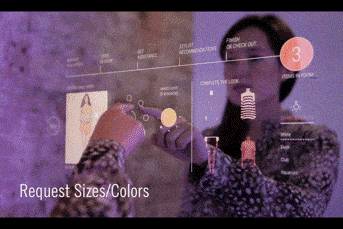Mirror, Mirror on the Wall

I really do not like to shop for clothes. The chaotic parking lots, long checkout lines, overly helpful store clerks and a selection of clothes with too many fits and styles all add to my frustration. However, I joined the Telerik Sitefinity team in October and I decided to purchase some new clothes to give my wardrobe a badly needed upgrade. The experience lived “up” to my expectations.
I arrived at the store and picked out a pair of pants and headed to the dressing room. Success - sort of. Now I needed some shirts to match the new pants. I traveled out yet again to the floor and proceeded to wreck the pile of neatly folded shirts to find my size.
You are probably asking: why not just shop online? I do find online shopping easier because I can simply browse a vast catalog of products, compare different pieces and get recommendations about similar items. These recommendations also help reduce some of my doubt when making a purchase. However, for clothes, I still like to try the items on to make sure they fit correctly. The ideal would be to have an in-store experience more closely match my online purchasing but historically this has not been possible. Fortunately, it look like help is on its way.

A new technology was recently introduced to help shoppers find the styles and colors they need while in a stores dressing room. The technology, developed by Oak Labs (video), upgrades the old dressing room mirror with an interactive touchscreen. The mirror is equipped with an RFID antenna that recognizes the clothes you brought into the dressing room. The mirror then displays these items on the mirror and you can use the touchscreen to select other sizes, colors and also see recommendations. You can also save the items to your phone. The mirror also helps with long checkout lines by allowing you to pay for the items in the dressing room. Ralph Lauren is the first retailer to use the technology.
A recent post on the RetailNext blog highlights the changing nature of in person shopping, “Processes, infrastructures and systems live behind the scenes and produce painless and frictionless shopping which shoppers may not see or hear, but nonetheless experience with pleasure. Expedited checkout, “click-and-collect” and curbside pick-up are three examples. Mobile wallet is another great example, but retailers still struggle to execute this initiative on a large scale. Product search and price look-up apps are other programs implemented to make shopping convenient.”
The Oak Lab interactive mirror is a good example of this trend. I think we will see stores utilize new technologies that make the online and offline experience more seamless in order to make the customer experience as painless and frictionless as possible. Stores can no longer treat the online vs. in-person shopping event as discrete, separate interactions. Regardless of the channel, a customer’s experience needs to be treated as one interaction and companies need to find a way to stitch them together for the consumer. The brands that are best able to link these two experiences together will have the greater chance of creating loyal, repeat customers.

Barrett Coakley
Barrett Coakley is the Senior Manager, Products Marketing for the Progress Sitefinity Content Management System (CMS) and the Sitefinity DEC, a digital marketing analytics platform. Mr. Coakley has worked in various marketing positions for both startup and large technology organizations for over 20 years.

Latest Stories in Your Inbox
Subscribe to get all the news, info and tutorials you need to build better business apps and sites